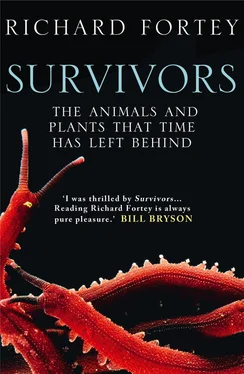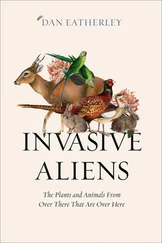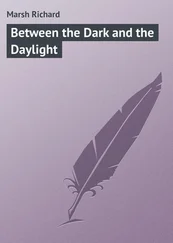This modern classification is the end point of a long scientific battle. The intellectual classes had been debating the question of the age of the earth since the Comte de Buffon’s estimate of 75,000 years in 1774 based upon the idea of the planet cooling down from a molten state. Apart from a purblind few who insisted (and indeed still insist) upon a biblical timescale based on totting up the generations mentioned in the Bible – Bishop Ussher’s 4004 BC estimate for the Creation – the time available to ‘evolve’ the earth increased fitfully throughout the early days of geology as a science. The bolder savants soon speculated in more and more millions. The longer time got, the more questions were raised about life’s early days, because of the apparent absence of ‘organic remains’ in Precambrian rocks. Charles Darwin famously fretted about it. Geologists of his time were beginning to explore large areas of the world comprised of Precambrian strata as the rocks of countries such as Canada were mapped for the first time. It was soon evident that sedimentary rocks, much like those found in younger geological formations, were widespread over these ancient lands. The seas were apparently barren in these ancient worlds; seas not so different in their physical properties from those that gave succour to the trilobites and snails that could be so easily collected from younger strata. In 1883 the American palaeontologist James Hall found some intensely layered Precambrian rocks apparently ‘growing’ upwards incrementally from a narrower base to which he gave the name Cryptozoon (‘hidden life’); however, their organic nature still remained controversial. Nonetheless, with the mere application of a scientific name, the biological virginity of the Precambrian had been breached. It was time for the stromatolites to be recognised as organic constructions.
The first time I saw fossil stromatolites in the Precambrian was as an undergraduate at the University of Cambridge, when I took part in an expedition to the Arctic island of Spitsbergen in 1967. My doctoral thesis was to be on rocks of Ordovician age exposed along the cold remote shore of Hinlopen Strait on the eastern side of a northerly peninsula called Ny Friesland. The small boat that took us to our field area dodged between ice floes stained with the droppings of countless seabirds, for the Arctic summer is a brief period of plenty for animals that live off the ocean. On land the scenery was bleak: a succession of cobbled beaches raised above the present sea level, across which the occasional polar bear or Arctic fox wandered in search of a feathered snack. It was not an inviting prospect, although it was to be my home for several months. On the way to reach my Ordovician rocks, and before passing the Cambrian strata that lay beneath them, the boat had to chug past a great thickness of even older Proterozoic limestone and shale, piled up layer on layer. There are few places in the world where a young scientist can cruise through such a momentous stretch of geological time, let alone along an outcrop that has survived so unaltered by subsequent earth movements. These ancient rocks were in almost pristine condition. On one occasion we landed to make a temporary camp and pick up fresh water. I wandered over to the nearby rock outcrop just to have a look. The rocks were not horizontal; instead they had been tipped gently (but less so than the rocks at Mistaken Point). I could easily make out the flat bedding planes breaking up the shore into a series of steps that recorded a succession of former sea floors. The rocks were a mixture. Most were very pale grey, sometimes almost pearly, and hard looking. Others were yellowish, in patches somewhat sugary and brightly tinted. The latter were dolomites, a calcium magnesium carbonate rock that at the present day particularly forms in areas surrounding the more arid tropical regions. The off-white rocks were limestones, that is, made of calcium carbonate in a finely crystalline form. Looking closely, I could now observe that several of the limestone surfaces were finely scored. Many years of erosion had picked out subtle differences in hardness within a single bed of limestone, so that lines even a millimetre or so apart could be clearly discerned. A comparison with layered pastry came to mind. I imagine that a blind man could have read the rock surface like Braille, just by gentle palpation. Where the rock surface was weathered at right angles to the bedding surface, providing a natural cross section, these finely-layered rocks were arranged in a series of undulating columns, widening a little from their base. They were stromatolites, or to be more accurate, sections through stromatolites – with a thousand years or more of slow growth preserved in a fossil grave of fine limestone. Cryptozoon proved to be not so cryptic after all; it was the stony legacy of cyanobacteria. When I followed the stromatolites over onto the bedding plane beyond to get a vision of the ancient sea floor, they converted into balloons or pillows stretching away from me, each one showing the top of a stromatolite head. This was the fossilised version of the view at Shark Bay I was to admire decades later. It was bleached to white limestone by the passage of a thousand million years, perhaps, but it was still recognisable, a picture petrified from a former earth. This was the nearest thing I will ever experience to being in a time machine, even if my appreciation of it were countermanded at once by the shrill cries of Arctic terns above my head: chicks to feed, human business to be done, and the earth has moved on. Nothing remains exactly the same forever.
Had I looked more widely along that unwelcoming shore I would have observed a greater variety of shapes carrying the telltale laminations of stromatolites. I would also have noticed some occasional shiny black patches within them; these are made of chert, a very hard, flinty rock composed of the mineral silica. Andrew Knoll, who is perhaps the doyen of Precambrian palaeontology, visited the same rocks in Spitsbergen a few years later, as he has described in his book Life on a Young Planet. From those cherts he recovered remarkable small fossils, which helped to make his reputation. He also recorded a whole range of different rock types produced by ancient micro-organisms; the most general term for these rocks is ‘microbialites’ which is a term that I trust does not require further explanation. Subtly mottled microbialites can present the appearance of ornamental marble, or the interior of a sponge cake, or the dimpled mats that I saw on Shark Bay; they can all be attributed to the work of bacteria and their relatives. Evidently, ancient microscopic communities did not just manufacture columns, though these do display several different shapes. Over much of the vast compass of Precambrian time it was a dominantly microbial world, and there was nothing to prevent tiny organisms from constructing a variety of edifices.
Stromatolite fossils are not at all rare if the right rocks are explored. It is not surprising that many rocks have been altered by heat or pressure if they have sojourned on the earth for billions of years. The great motor of plate tectonics has been continuously in operation, building mountains and moving continents around. It is a lucky rock that escapes unscathed. Most of those that have successfully dodged being crunched or heated up are found around the edges of the most ancient and stable continental cores often known as ‘shields’. These bits of earth’s crust stabilised early on, and have been pushed around the earth during successive phases of continent building rather like counters being shoved around a draughts board. They survive to play another game. If there are patches of stromatolites preserved upon them, they are handed onwards. Perhaps the Canadian Shield is the best known of these ancient areas, but parts of southern Africa and Western Australia are equally familiar to geologists. However, the list of stromatolite occurrences is much longer than that of ancient shield areas, the rocks Andrew Knoll and I examined in Spitsbergen being a case in point. It is obvious that these strange organic structures were almost ubiquitous at least in the shallower parts of ancient oceans. Cyanobacteria would have needed light to grow, so the particular stromatolitic structures made by them must have been confined to comparatively shallow water. The early Precambrian ocean depths are unknown to us, since ocean floors are consumed in the inexorable slow dance of the plates. But it is more than likely that there, too, were structures made by different bacteria that flourished away from light. After all, life never misses a trick.
Читать дальше












